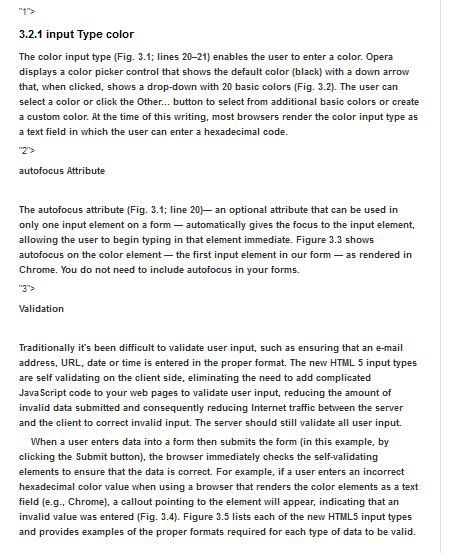Answered step by step
Verified Expert Solution
Question
1 Approved Answer
(Laying Out Book Pages in HTML5: Creating the Sections) Mark Up the paragraph text from section 3.2.1 of this chapter as a web page using
(Laying Out Book Pages in HTML5: Creating the Sections) Mark Up the paragraph text from section 3.2.1 of this chapter as a web page using page-structure elements. The text is provided in the exerciseTextAndImages folder with this chapters examples. Do not include the figures in this exercise.
(3.2.1 text)
Program Plan: 
Create a HTML file for the following:
Applying section element without figures on the chapter 3.2.1
Use of page structure element.
Use of mark--- up paragraph
3.2.1 input Type color The color input type (Fig. 3.1; lines 20-21) enables the user to enter a color. Opera displays a color picker control that shows the default color (black) with a down arrow that, when clicked, shows a drop-down with 20 basic colors (Fig. 3.2). The user can select a color or click the Other... button to select from additional basic colors or create a custom color. At the time of this writing, most browsers render the color input type as a text field in which the user can enter a hexadecimal code. autofocus Attribute The autofocus attribute (Fig. 3.1; line 20-an optional attribute that can be used in only one input element on a form automatically gives the focus to the input element, allowing the user to begin typing in that element immediate. Figure 3.3 shows autofocus on the color element the first input element in our form as rendered in Chrome. You do not need to include autofocus in your forms. Traditionally it's been difficult to validate user input, such as ensuring that an e-mail address, URL, date or time is entered in the proper format. The new HTML 5 input types are self validating on the client side, eliminating the need to add complicated Java Script code to your web pages to validate user input, reducing the amount of invalid data submitted and consequently reducing Internet traffic between the server and the client to correct invalid input. The server should still validate all user input. When a user enters data into a form then submits the form (in this example, by clicking the Submit button), the browser immediately checks the self-validating elements to ensure that the data is correct. For example, if a user enters an incorrect hexadecimal color value when using a browser that renders the color elements as a text field (e.g., Chrome), a callout pointing to the element will appear, indicating that an invalid value was entered (Fig. 3.4). Figure 3.5 lists each of the new HTML5 input types and provides examples of the proper formats required for each type of data to be validStep by Step Solution
There are 3 Steps involved in it
Step: 1

Get Instant Access to Expert-Tailored Solutions
See step-by-step solutions with expert insights and AI powered tools for academic success
Step: 2

Step: 3

Ace Your Homework with AI
Get the answers you need in no time with our AI-driven, step-by-step assistance
Get Started


